Business Decision Making: A&B plc Investment Feasibility Report
VerifiedAdded on 2023/01/07
|7
|1309
|98
Report
AI Summary
This report assesses the feasibility of investment proposals for A&B plc, utilizing Net Present Value (NPV) and Payback Period (PBP) techniques. The analysis compares two projects, Project A and Project B, calculating their NPV and payback periods to determine the more profitable investment. Project A is recommended due to its higher NPV and shorter payback period. The report also discusses various factors influencing financial decision-making, including cost-risk relationships, availability of liquid assets, profitability, market potential, customer base management, and management efficiency. These factors are crucial for making informed investment choices, with the conclusion favoring investment in Project A for its higher profitability.

Business Decision Making
Paraphrase This Document
Need a fresh take? Get an instant paraphrase of this document with our AI Paraphraser

TABLE OF CONTENTS
Evaluating the feasibility of investment proposals for A&B plc...........................................3
Different factor considers at the time of making financial decision......................................5
REFERENCES...........................................................................................................................7
Evaluating the feasibility of investment proposals for A&B plc...........................................3
Different factor considers at the time of making financial decision......................................5
REFERENCES...........................................................................................................................7
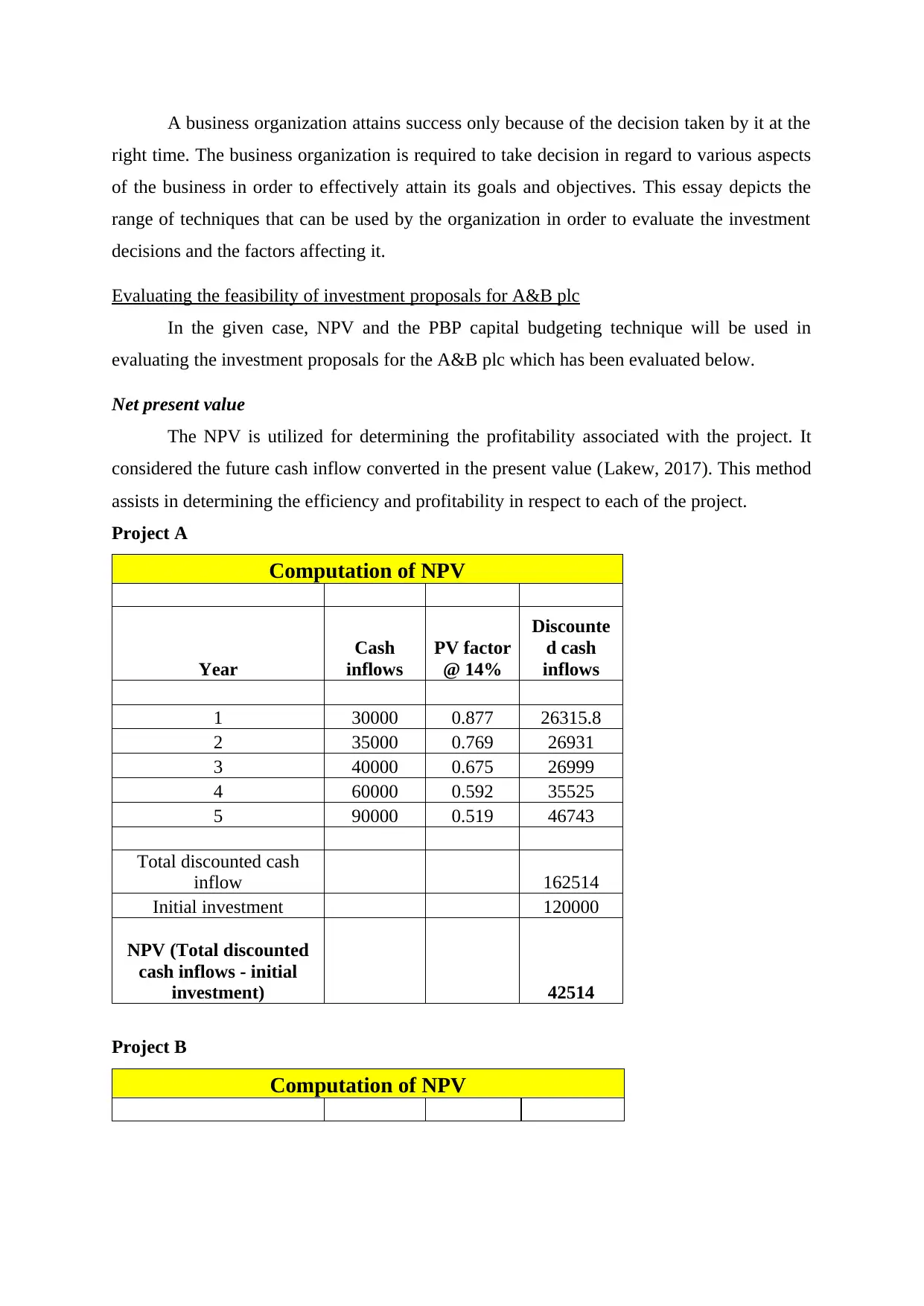
A business organization attains success only because of the decision taken by it at the
right time. The business organization is required to take decision in regard to various aspects
of the business in order to effectively attain its goals and objectives. This essay depicts the
range of techniques that can be used by the organization in order to evaluate the investment
decisions and the factors affecting it.
Evaluating the feasibility of investment proposals for A&B plc
In the given case, NPV and the PBP capital budgeting technique will be used in
evaluating the investment proposals for the A&B plc which has been evaluated below.
Net present value
The NPV is utilized for determining the profitability associated with the project. It
considered the future cash inflow converted in the present value (Lakew, 2017). This method
assists in determining the efficiency and profitability in respect to each of the project.
Project A
Computation of NPV
Year
Cash
inflows
PV factor
@ 14%
Discounte
d cash
inflows
1 30000 0.877 26315.8
2 35000 0.769 26931
3 40000 0.675 26999
4 60000 0.592 35525
5 90000 0.519 46743
Total discounted cash
inflow 162514
Initial investment 120000
NPV (Total discounted
cash inflows - initial
investment) 42514
Project B
Computation of NPV
right time. The business organization is required to take decision in regard to various aspects
of the business in order to effectively attain its goals and objectives. This essay depicts the
range of techniques that can be used by the organization in order to evaluate the investment
decisions and the factors affecting it.
Evaluating the feasibility of investment proposals for A&B plc
In the given case, NPV and the PBP capital budgeting technique will be used in
evaluating the investment proposals for the A&B plc which has been evaluated below.
Net present value
The NPV is utilized for determining the profitability associated with the project. It
considered the future cash inflow converted in the present value (Lakew, 2017). This method
assists in determining the efficiency and profitability in respect to each of the project.
Project A
Computation of NPV
Year
Cash
inflows
PV factor
@ 14%
Discounte
d cash
inflows
1 30000 0.877 26315.8
2 35000 0.769 26931
3 40000 0.675 26999
4 60000 0.592 35525
5 90000 0.519 46743
Total discounted cash
inflow 162514
Initial investment 120000
NPV (Total discounted
cash inflows - initial
investment) 42514
Project B
Computation of NPV
⊘ This is a preview!⊘
Do you want full access?
Subscribe today to unlock all pages.

Trusted by 1+ million students worldwide
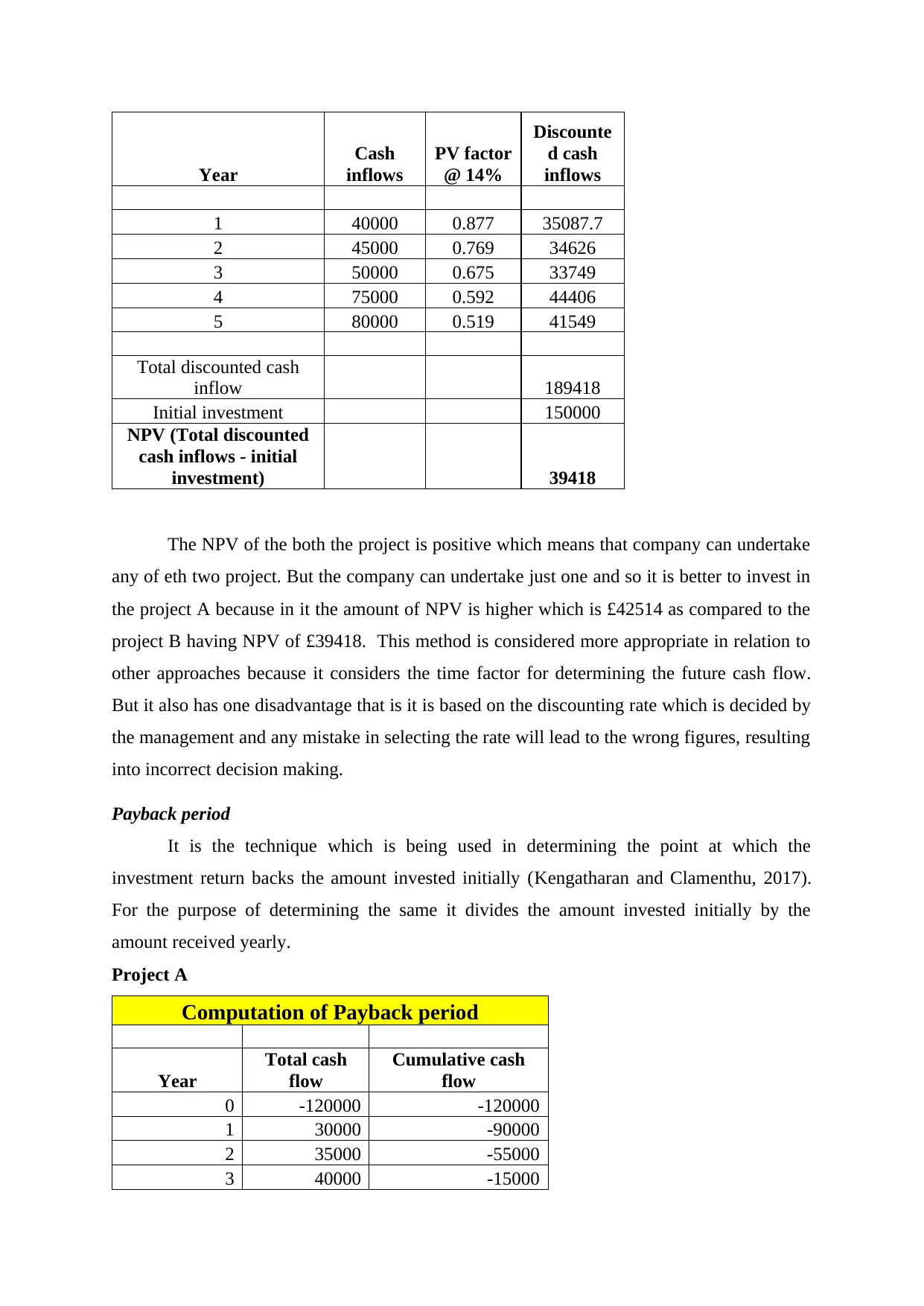
Year
Cash
inflows
PV factor
@ 14%
Discounte
d cash
inflows
1 40000 0.877 35087.7
2 45000 0.769 34626
3 50000 0.675 33749
4 75000 0.592 44406
5 80000 0.519 41549
Total discounted cash
inflow 189418
Initial investment 150000
NPV (Total discounted
cash inflows - initial
investment) 39418
The NPV of the both the project is positive which means that company can undertake
any of eth two project. But the company can undertake just one and so it is better to invest in
the project A because in it the amount of NPV is higher which is £42514 as compared to the
project B having NPV of £39418. This method is considered more appropriate in relation to
other approaches because it considers the time factor for determining the future cash flow.
But it also has one disadvantage that is it is based on the discounting rate which is decided by
the management and any mistake in selecting the rate will lead to the wrong figures, resulting
into incorrect decision making.
Payback period
It is the technique which is being used in determining the point at which the
investment return backs the amount invested initially (Kengatharan and Clamenthu, 2017).
For the purpose of determining the same it divides the amount invested initially by the
amount received yearly.
Project A
Computation of Payback period
Year
Total cash
flow
Cumulative cash
flow
0 -120000 -120000
1 30000 -90000
2 35000 -55000
3 40000 -15000
Cash
inflows
PV factor
@ 14%
Discounte
d cash
inflows
1 40000 0.877 35087.7
2 45000 0.769 34626
3 50000 0.675 33749
4 75000 0.592 44406
5 80000 0.519 41549
Total discounted cash
inflow 189418
Initial investment 150000
NPV (Total discounted
cash inflows - initial
investment) 39418
The NPV of the both the project is positive which means that company can undertake
any of eth two project. But the company can undertake just one and so it is better to invest in
the project A because in it the amount of NPV is higher which is £42514 as compared to the
project B having NPV of £39418. This method is considered more appropriate in relation to
other approaches because it considers the time factor for determining the future cash flow.
But it also has one disadvantage that is it is based on the discounting rate which is decided by
the management and any mistake in selecting the rate will lead to the wrong figures, resulting
into incorrect decision making.
Payback period
It is the technique which is being used in determining the point at which the
investment return backs the amount invested initially (Kengatharan and Clamenthu, 2017).
For the purpose of determining the same it divides the amount invested initially by the
amount received yearly.
Project A
Computation of Payback period
Year
Total cash
flow
Cumulative cash
flow
0 -120000 -120000
1 30000 -90000
2 35000 -55000
3 40000 -15000
Paraphrase This Document
Need a fresh take? Get an instant paraphrase of this document with our AI Paraphraser
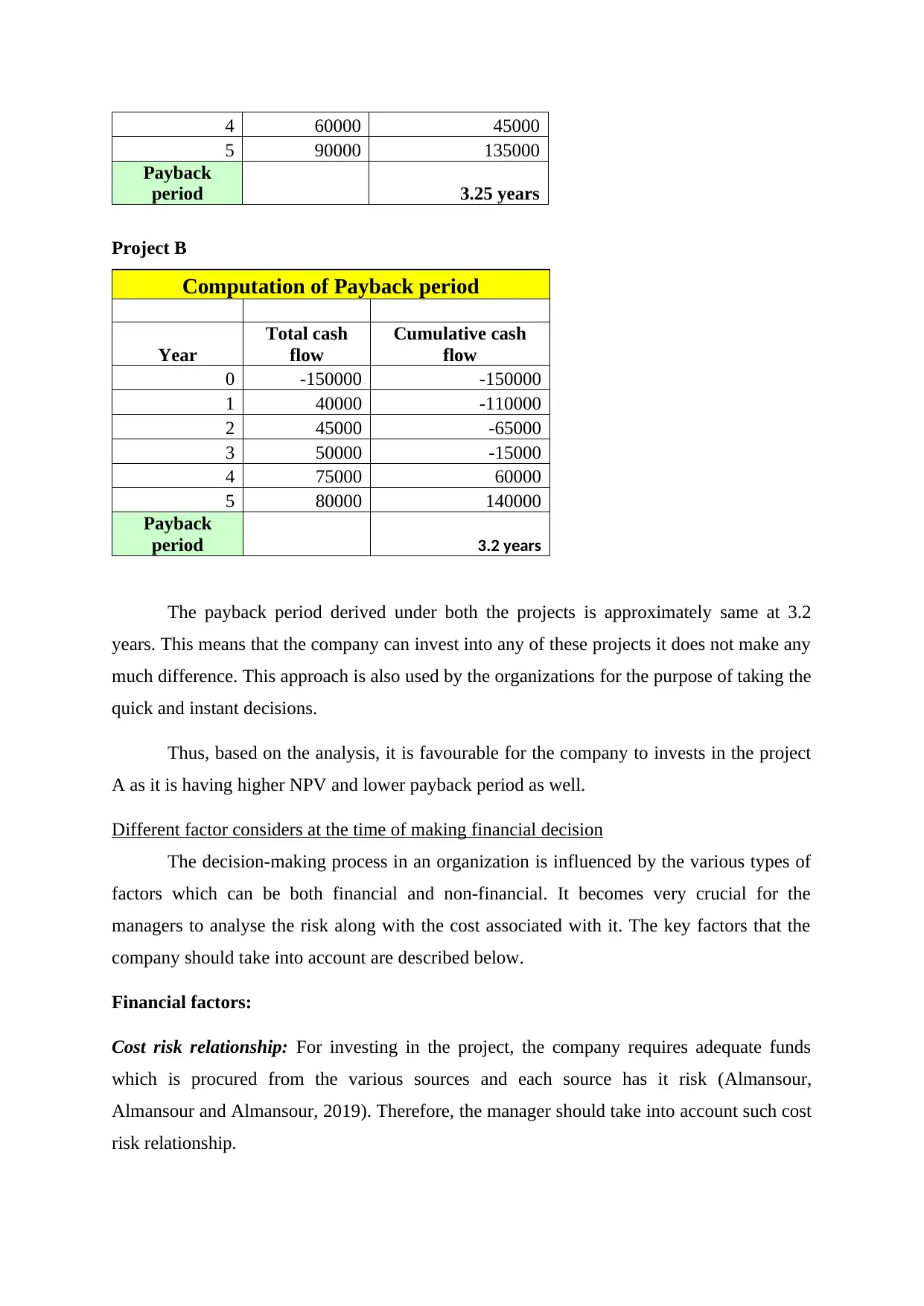
4 60000 45000
5 90000 135000
Payback
period 3.25 years
Project B
Computation of Payback period
Year
Total cash
flow
Cumulative cash
flow
0 -150000 -150000
1 40000 -110000
2 45000 -65000
3 50000 -15000
4 75000 60000
5 80000 140000
Payback
period 3.2 years
The payback period derived under both the projects is approximately same at 3.2
years. This means that the company can invest into any of these projects it does not make any
much difference. This approach is also used by the organizations for the purpose of taking the
quick and instant decisions.
Thus, based on the analysis, it is favourable for the company to invests in the project
A as it is having higher NPV and lower payback period as well.
Different factor considers at the time of making financial decision
The decision-making process in an organization is influenced by the various types of
factors which can be both financial and non-financial. It becomes very crucial for the
managers to analyse the risk along with the cost associated with it. The key factors that the
company should take into account are described below.
Financial factors:
Cost risk relationship: For investing in the project, the company requires adequate funds
which is procured from the various sources and each source has it risk (Almansour,
Almansour and Almansour, 2019). Therefore, the manager should take into account such cost
risk relationship.
5 90000 135000
Payback
period 3.25 years
Project B
Computation of Payback period
Year
Total cash
flow
Cumulative cash
flow
0 -150000 -150000
1 40000 -110000
2 45000 -65000
3 50000 -15000
4 75000 60000
5 80000 140000
Payback
period 3.2 years
The payback period derived under both the projects is approximately same at 3.2
years. This means that the company can invest into any of these projects it does not make any
much difference. This approach is also used by the organizations for the purpose of taking the
quick and instant decisions.
Thus, based on the analysis, it is favourable for the company to invests in the project
A as it is having higher NPV and lower payback period as well.
Different factor considers at the time of making financial decision
The decision-making process in an organization is influenced by the various types of
factors which can be both financial and non-financial. It becomes very crucial for the
managers to analyse the risk along with the cost associated with it. The key factors that the
company should take into account are described below.
Financial factors:
Cost risk relationship: For investing in the project, the company requires adequate funds
which is procured from the various sources and each source has it risk (Almansour,
Almansour and Almansour, 2019). Therefore, the manager should take into account such cost
risk relationship.
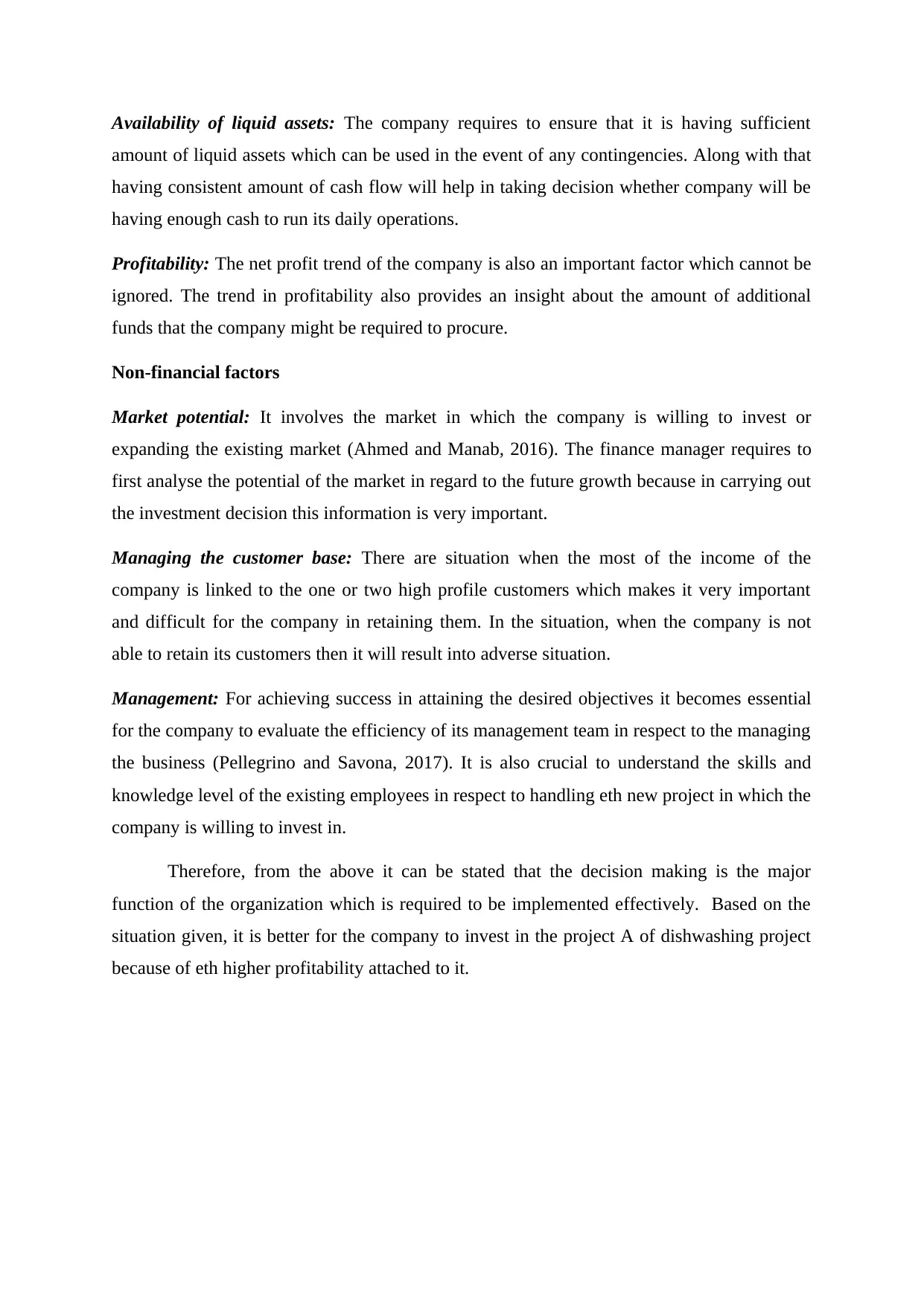
Availability of liquid assets: The company requires to ensure that it is having sufficient
amount of liquid assets which can be used in the event of any contingencies. Along with that
having consistent amount of cash flow will help in taking decision whether company will be
having enough cash to run its daily operations.
Profitability: The net profit trend of the company is also an important factor which cannot be
ignored. The trend in profitability also provides an insight about the amount of additional
funds that the company might be required to procure.
Non-financial factors
Market potential: It involves the market in which the company is willing to invest or
expanding the existing market (Ahmed and Manab, 2016). The finance manager requires to
first analyse the potential of the market in regard to the future growth because in carrying out
the investment decision this information is very important.
Managing the customer base: There are situation when the most of the income of the
company is linked to the one or two high profile customers which makes it very important
and difficult for the company in retaining them. In the situation, when the company is not
able to retain its customers then it will result into adverse situation.
Management: For achieving success in attaining the desired objectives it becomes essential
for the company to evaluate the efficiency of its management team in respect to the managing
the business (Pellegrino and Savona, 2017). It is also crucial to understand the skills and
knowledge level of the existing employees in respect to handling eth new project in which the
company is willing to invest in.
Therefore, from the above it can be stated that the decision making is the major
function of the organization which is required to be implemented effectively. Based on the
situation given, it is better for the company to invest in the project A of dishwashing project
because of eth higher profitability attached to it.
amount of liquid assets which can be used in the event of any contingencies. Along with that
having consistent amount of cash flow will help in taking decision whether company will be
having enough cash to run its daily operations.
Profitability: The net profit trend of the company is also an important factor which cannot be
ignored. The trend in profitability also provides an insight about the amount of additional
funds that the company might be required to procure.
Non-financial factors
Market potential: It involves the market in which the company is willing to invest or
expanding the existing market (Ahmed and Manab, 2016). The finance manager requires to
first analyse the potential of the market in regard to the future growth because in carrying out
the investment decision this information is very important.
Managing the customer base: There are situation when the most of the income of the
company is linked to the one or two high profile customers which makes it very important
and difficult for the company in retaining them. In the situation, when the company is not
able to retain its customers then it will result into adverse situation.
Management: For achieving success in attaining the desired objectives it becomes essential
for the company to evaluate the efficiency of its management team in respect to the managing
the business (Pellegrino and Savona, 2017). It is also crucial to understand the skills and
knowledge level of the existing employees in respect to handling eth new project in which the
company is willing to invest in.
Therefore, from the above it can be stated that the decision making is the major
function of the organization which is required to be implemented effectively. Based on the
situation given, it is better for the company to invest in the project A of dishwashing project
because of eth higher profitability attached to it.
⊘ This is a preview!⊘
Do you want full access?
Subscribe today to unlock all pages.

Trusted by 1+ million students worldwide
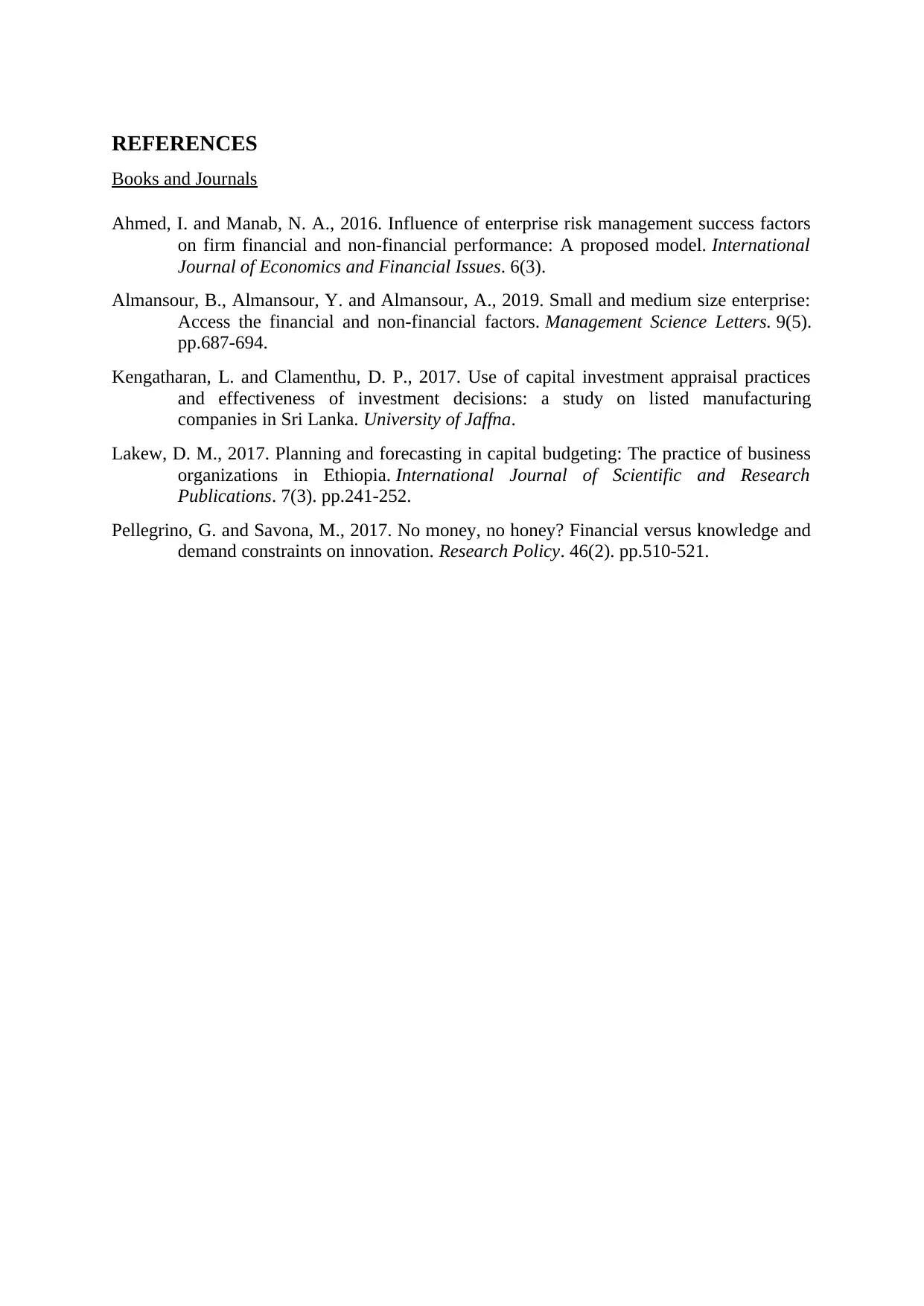
REFERENCES
Books and Journals
Ahmed, I. and Manab, N. A., 2016. Influence of enterprise risk management success factors
on firm financial and non-financial performance: A proposed model. International
Journal of Economics and Financial Issues. 6(3).
Almansour, B., Almansour, Y. and Almansour, A., 2019. Small and medium size enterprise:
Access the financial and non-financial factors. Management Science Letters. 9(5).
pp.687-694.
Kengatharan, L. and Clamenthu, D. P., 2017. Use of capital investment appraisal practices
and effectiveness of investment decisions: a study on listed manufacturing
companies in Sri Lanka. University of Jaffna.
Lakew, D. M., 2017. Planning and forecasting in capital budgeting: The practice of business
organizations in Ethiopia. International Journal of Scientific and Research
Publications. 7(3). pp.241-252.
Pellegrino, G. and Savona, M., 2017. No money, no honey? Financial versus knowledge and
demand constraints on innovation. Research Policy. 46(2). pp.510-521.
Books and Journals
Ahmed, I. and Manab, N. A., 2016. Influence of enterprise risk management success factors
on firm financial and non-financial performance: A proposed model. International
Journal of Economics and Financial Issues. 6(3).
Almansour, B., Almansour, Y. and Almansour, A., 2019. Small and medium size enterprise:
Access the financial and non-financial factors. Management Science Letters. 9(5).
pp.687-694.
Kengatharan, L. and Clamenthu, D. P., 2017. Use of capital investment appraisal practices
and effectiveness of investment decisions: a study on listed manufacturing
companies in Sri Lanka. University of Jaffna.
Lakew, D. M., 2017. Planning and forecasting in capital budgeting: The practice of business
organizations in Ethiopia. International Journal of Scientific and Research
Publications. 7(3). pp.241-252.
Pellegrino, G. and Savona, M., 2017. No money, no honey? Financial versus knowledge and
demand constraints on innovation. Research Policy. 46(2). pp.510-521.
1 out of 7
Related Documents
Your All-in-One AI-Powered Toolkit for Academic Success.
+13062052269
info@desklib.com
Available 24*7 on WhatsApp / Email
![[object Object]](/_next/static/media/star-bottom.7253800d.svg)
Unlock your academic potential
Copyright © 2020–2025 A2Z Services. All Rights Reserved. Developed and managed by ZUCOL.





